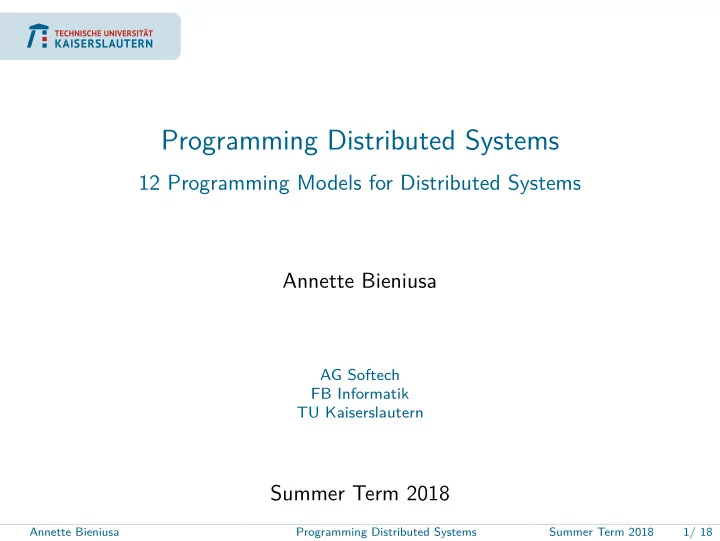

Programming Distributed Systems 12 Programming Models for Distributed Systems Annette Bieniusa AG Softech FB Informatik TU Kaiserslautern Summer Term 2018 Annette Bieniusa Programming Distributed Systems Summer Term 2018 1/ 18
What is a Programming Model?[3] A programming model is some form of abstract machine Provides operations to the level above Requires implementations for these operations on the level(s) below Simplification through abstraction Standard interface that remains stable even if underlying architecture changes Provide different levels of abstraction Often starting point for language development ⇒ Separation of concern between software developers and framework implementors (runtime system, compiler, etc.) Annette Bieniusa Programming Distributed Systems Summer Term 2018 2/ 18
Properties of good programming models Meaningful abstractions System-architecture independent Efficiently implementable Easy to understand Annette Bieniusa Programming Distributed Systems Summer Term 2018 3/ 18
What kind of abstractions should a programming model for distributed systems provide? Annette Bieniusa Programming Distributed Systems Summer Term 2018 4/ 18
Remote Procedure Call Annette Bieniusa Programming Distributed Systems Summer Term 2018 5/ 18
Remote Procedure Call (RPC) Rather broad classifying term with changing meaning over time From client-server design to interconnected services Two entities (caller/callee) with different address spaces communicate over some channel in a request-response mechanism Examples: CORBA (Common Object Request Broker Architecture), Java RMI (Remote Method Invocation), SOAP (Simple Object Access Protocol), gRPC, Finagle . . . Annette Bieniusa Programming Distributed Systems Summer Term 2018 6/ 18
Annette Bieniusa Programming Distributed Systems Summer Term 2018 7/ 18
Aspects of modern RPC Language-agnostic Serialization (aka marshalling or pickling) JSON, XML, Protocol Buffers, . . . Load-balancing Microservice architectures! Asynchronous ⇒ RPC as term gets more and more diffuse Annette Bieniusa Programming Distributed Systems Summer Term 2018 8/ 18
Futures and Promises “Asynchronous RPC” A future is a value that will eventually become available Two states: completed : value is available incomplete : computation for value is not yet complete Strategies: Eager vs. lazy evaluation Typical application: Web development and user interfaces Annette Bieniusa Programming Distributed Systems Summer Term 2018 9/ 18
Actors and Message Passing Annette Bieniusa Programming Distributed Systems Summer Term 2018 10/ 18
Characteristics of Actor Model[2] Actors are isolated units of computation+state that can send messages asynchronously to each other Messages are queued in mailbox and processed sequentially when they match against some pattern/rule No assumptions on message delivery guarantees (Potential) State+behavior changes upon message processing[1] Very close to Alan Kay’s definition of Object-Oriented Programming Annette Bieniusa Programming Distributed Systems Summer Term 2018 11/ 18
Actors in the Wild Erlang Process-based Pure message passing monitor and link for notification of process failure/shutdown OTP (Open Telecom Platform) for generic reusable patterns Akka Actor model for the JVM Purges non-matching messages Enforces parental supervision Included in Scala standard library Orleans Cloud computing Scalability by replication Fine-grain reconciliation of state with transactions Annette Bieniusa Programming Distributed Systems Summer Term 2018 12/ 18
And more programming models “Big data” Batch-processing Static data sets allow to distribute computation Typically large latencies Stream-processing (Infinite) Sequence of data being pushed to processors Producers vs. Consumers Notion of windows and time Example: Kafka Annette Bieniusa Programming Distributed Systems Summer Term 2018 13/ 18
The Future: Distributed Programming Languages Annette Bieniusa Programming Distributed Systems Summer Term 2018 14/ 18
From Model to Language Challenges: Partial failure, concurrency and consistency, latency, . . . 1. Distributed Shared Memory Runtime maps virtual addresses to physical ones “Single-system” illusion 2. Actors Explicit communication Location of processes is transparent 3. Dataflow Data transformations expressed as DAG Processes are transparent Example: MapReduce (Google), Dryad (Microsoft), Spark Annette Bieniusa Programming Distributed Systems Summer Term 2018 15/ 18
Example: WordCount in MapReduce Annette Bieniusa Programming Distributed Systems Summer Term 2018 16/ 18
Further reading Material collection by Northeastern University, CS7680 Special Topics in Computing Systems: Programming Models for Distributed Computing Annette Bieniusa Programming Distributed Systems Summer Term 2018 17/ 18
[1] Gul Agha. “Concurrent Object-Oriented Programming”. In: Commun. ACM 33.9 (1990), S. 125–141. doi : 10.1145/83880.84528. url : http://doi.acm.org/10.1145/83880.84528. [2] Carl Hewitt, Peter Boehler Bishop und Richard Steiger. “A Universal Modular ACTOR Formalism for Artificial Intelligence”. In: Proceedings of the 3rd International Joint Conference on Artificial Intelligence. Standford, CA, USA, August 20-23, 1973 . Hrsg. von Nils J. Nilsson. William Kaufmann, 1973, S. 235–245. url : http://ijcai.org/Proceedings/73/Papers/027B.pdf. [3] David B. Skillicorn und Domenico Talia. “Models and Languages for Parallel Computation”. In: ACM Comput. Surv. 30.2 (1998), S. 123–169. doi : 10.1145/280277.280278. url : http://doi.acm.org/10.1145/280277.280278. Annette Bieniusa Programming Distributed Systems Summer Term 2018 18/ 18
Recommend
More recommend